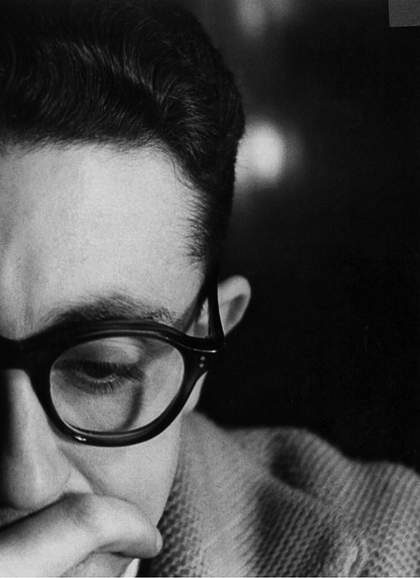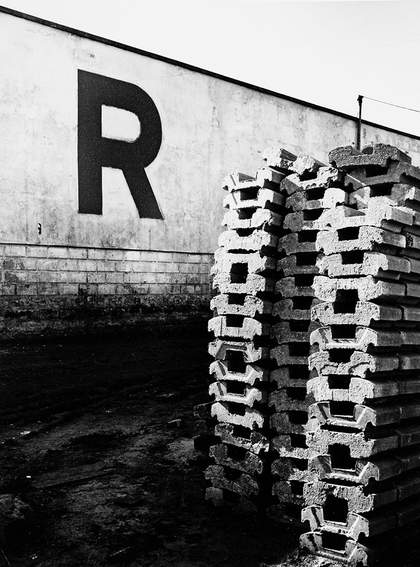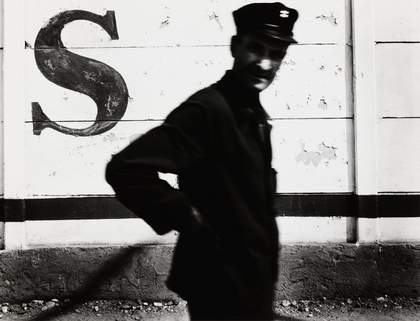
Alfredo Camisa self-portrait (undated)
© Estate of Alfredo Camisa, courtesy Marta Camisa
Like many of the celebrated figures in photography at the time, Alfredo Camisa – who was born in Bologna in 1927 and grew up in Florence – was not a professional but a dedicated amateur; a chemical engineer, whose real involvement in the art form began in 1955 in Milan, where he moved to take a job at an oil company.
Exposed for the first time to the activity of photo clubs and their culture of manifestos, exhibitions and prizes, and enthused by the diverse work he saw in shows that were beginning to tour to Italy from abroad, he quickly integrated himself into the photographic community. Camisa published critical essays and formed extensive bodies of correspondence with prominent figures including Cavalli and Branzi, submitted his photographs to salons and found an outlet for his work in regular publication in the weekly political magazine Il Mondo and commissions for a small number of illustrated books.
By the end of the decade, he had achieved recognition beyond Italy, with the important exhibitions Photography at Mid-Century in 1959 at George Eastman House, New York, and Subjektive Fotografie, which toured from Germany in the 1950s, both including his images. ‘Alfredo Camisa has exercised a distinct influence on the photography of his fellow countrymen,’ noted an entry in the 1960 edition of Photography Year Book, a British annual. ‘With other young Italians he has helped to bring about a new movement. When it is remembered that he is a non-professional and that his photography is a product of his spare time, the development he has made seems all the more remarkable.’

Alfredo Camisa
Urban Alphabet R 1961 printed 2005
Gelatin silver print on paper, 405 x 305mm
© the artist, courtesy Massimo Prelz Oltramonti
Camisa’s job required a considerable amount of travel, and it was in the people and places he encountered in north Africa, Europe and the less-industrialised south of Italy, as well as on the streets and in the theatre of his adopted city, that he found his subject matter. Though this tended to invite associations with neorealism – the increasingly popular tendency to portray life in post-war Italy in a gritty but poetic manner – he was clear about his distaste for labels, describing them as ‘artificial, approximate, simplifying’. He preferred instead to emphasise the balance in his work between the technical lessons of his early associations with the formalist avant-garde group La Bussola and its founders Cavalli and Veronesi and an intuitive, personal response to the vernacular.
Made between 1955 and 1961, the 16 photographs that comprise Alfabeto Urbano are the results of a challenge that Camisa set himself to capture each letter of the alphabet from signage that he came across. Each image can be seen as a different formal exercise, showing experiment with composition, framing and characteristic use of high contrast to draw attention to textures, lines and forms. True to his wish to distance himself from reportage, any people in the frame appear secondary to the graphic shapes of their surroundings.

Alfredo Camisa
Urban Alphabet S, 1959 printed 2005
Photograph, gelatin silver print on paper, 305 x 405 mm
© Estate of Alfredo Camisa
The locations in which he found the letters were varied – beaches, old Milanese factories and underpasses on the city outskirts all feature – but for him precise location was unimportant. What mattered was what the spaces and subjects, ‘the suburbs, the desolate interiors, the old signboards, and those crafts doomed to extinction’ as Camisa described them, represented for him: a fading age that, in the context of increasingly globalised postwar culture, charmed and intrigued him. Writing decades later, he indicated the importance of this within his practice: ‘If I had continued to take pictures, I would have certainly given space to the so-called “industrial archaeology”.’
Camisa did not continue, however, and in 1961 withdrew from photography altogether, leaving the project unfinished, the challenge incomplete (it wasn’t until 2005 that he returned to his archives to compile the definitive series of this work).
Later, in a typed note, Epitaph on my photographic biography, he cited his reason for quitting as an inability to reconcile his desire to photograph as a means of pure expression with the fact that it would be necessary to work on commission to pursue his practice any further. ‘The decision was drastic and irrevocable,’ he wrote. ‘It was a painful decision, but the right one back then. Today, maybe today, it would be completely different.’
